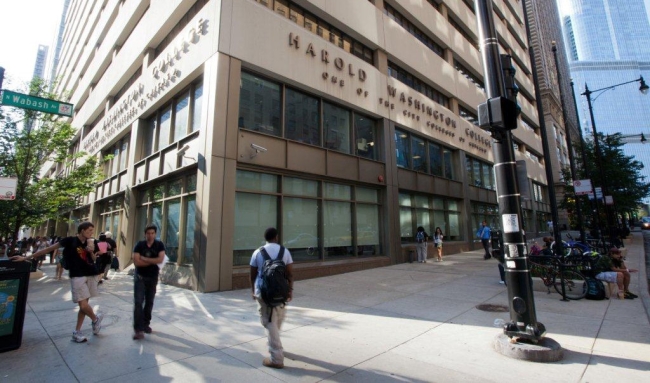You have /5 articles left.
Sign up for a free account or log in.

Harold Washington College, one of seven City Colleges of Chicago
Flickr
A new tuition structure from Chicago's community college system seeks to incentivize full-time enrollment while still discounting tuition for part-time students.
The new structure takes elements of popular completion-movement reforms like 15 to Finish while attempting to eliminate criticism that such programs penalize the many students who juggle responsibilities off campus and can only attend part-time.
Reforms that encourage full-time enrollment draw from analyses that show students who take more credits or attend full-time are more likely to complete college not only on time but with less debt and fewer opportunities to drop out.
City Colleges of Chicago in 2015 revamped its tuition structure to make tuition less expensive the more credits a student carries. One course costs $599, for example, but taking five to 11 credits costs $1,069, and those who took at least 12 credits -- or were considered full-time -- paid a $1,753 flat tuition fee. Prior to introducing this structure, City Colleges charged less expensive tuition at $89 per credit hour, in addition to fees.
City Colleges officials' decision to discount full-time tuition was controversial at the time. The system also was considering a number of program consolidations and other changes to increase completion rates. Many faculty members feared the moves would harm lower-income and part-time students.
"We're keeping the best elements of the 2015 plan, and the adjustment we're making here is with part-time students," said Juan Salgado, City Colleges' chancellor. "We understand part-time students take a part-time course load based on the rhythm of their lives. It's based on family and work responsibilities."
Last week the system's governing board approved changes to the part-time rate, including a 25 percent cut to the cost of a single course. Now any course load that's less than 12 credits is $146 per credit hour, while the full-time rate decreased by $1. Meanwhile, City Colleges remains the only two-year system in the state not to charge ancillary fees.
"We now have a system where some part-time students pay more, and some part-time students pay less, but that's why we're calling it fair … pay for what you take in terms of credit hours," Salgado said, adding that it wasn't fair when students taking five credits paid the same amount as those taking 11 credits. "What we [had] is some part-time students paying significantly more than others when we know incentives for part-time students don't really equal more course taking because they have family and work obligations."
Salgado pointed to students in early-childhood education programs, for example, who are either already working and want to upskill or are working in another industry and want to move into that field. These students tend to consume their educations one to two courses at a time, he said.
"It's that segment of the population we want to attract more," said Salgado, "and we want to make sure we're accessible and affordable."
He also doesn't believe the new plan conflicts with the goals of encouraging full-time status. Students often float between part-time and full-time status and choose to take more credits the closer they get to earning a degree, he said.
"Our flat rate is there in order to encourage that to happen and in recognition of the fact that we want those students to accelerate their learning and complete quicker," Salgado said. "The change with the part-time rate is simply a recognition that many students don't fit that mold. They are in fact part-time because they have to be part-time."
Bruce Vandal is senior vice president of Complete College America, a group that advocates for more students going full-time as a way of increasing completion. He said colleges recognize every student can't manage full-time enrollment, and they should also use strategies like clear pathways to credentials, proactive advising and reforms to developmental education in order to improve the likelihood of success for their part-time students.
"We applaud efforts that make college more affordable, but every step we take must recognize that the longer it takes to graduate the more life gets in the way," Vandal said via email. "That's why Complete College America advocates that many more students take 30 credits per year, setting them on a course for on-time completion."
Other states and systems are shifting to discounting full-time status for students. For example, Tennessee governor Bill Haslam called for a new requirement to the state's free community college program that students complete 30 credits per year to maintain eligibility for the scholarship. Texas A&M University at San Antonio is one of a number of four-year universities that encourage students to complete 15 credits a semester.
Under Chicago's new tuition plan, there is still potential for students to take more than 12 credits, but only if it's marketed to them as a financial incentive, said Davis Jenkins, a senior research scholar at the Community College Research Center at Columbia University's Teachers College. Jenkins served as an adviser to City Colleges' former chancellor, Cheryl Hyman, on several reforms within the system, including the flat tuition structure.
But Jenkins isn't optimistic the new changes will work.
"It likely won't be conveyed to students based on the conventional mind-set in community colleges, which is that encouraging students to take fewer courses is often a good thing because so many have work, family and other demands outside of school," he said. "But completion rates for part-time students are abysmal, and the few who go part-time and complete end up paying much more for their degrees."
Jenkins points to research that shows colleges may be underestimating the number of credits students can take.
"By better scheduling courses on students' plans, we believe that colleges can increase the number of credits students take in a term -- 12 instead of nine or 15 instead of 12 -- and thereby lower the time to degree for students and increase full-time-equivalent revenue for colleges," he said. "So rather than argue about whether students should be full-time or part-time … we should be thinking in terms of whether students are on plan or off plan and let them choose the pace at which they want to complete, knowing that the college will offer the courses they need on their plans when they need them."








